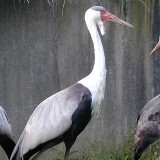CLASSIFICATION
Order: Gruiformes
Family: Gruidae
Genus: Bugeranus
Species: carunculatus
RANGE
Ethiopia, Central and Southern Africa. The Okavango Delta in Botswana is one of the most important breeding grounds.
HABITAT
Large open areas of wet grassland, sedge marsh and river edge.
SIZE
4 feet tall.
LIFE EXPECTANCY
Wild: Unknown.
Captivity: Up to 25 – 40 years or longer.
REPRODUCTION
- Monogamous, forming pair bonds for life.
- Reproductive state of both male and female is synchronized by bodily cycles, weather and length of daylight.
- Courtship displays include nuptial dancing, unison calls, running and jumping into the air. Unison calls are produced during the first days of breeding season only.
- Mated pairs build a circular nest of marsh grasses.
- Usually only one buff, spotted egg is laid. If two eggs are laid and both hatch, one chick is left at the nest site to perish.
- Incubation takes 32 – 40 days. Both parents incubate the egg, care for and feed the chick.
The chick remains with the parents until it develops flight feathers at 10 – 12 months. It then forms a flock with other non-breeding birds. - Chicks reach sexual maturity at four years.
DIET
Wild: Chiefly sedge, tubers and rhizomes. Occasionally grain, seeds, insects, snails, small fish, frogs and reptiles.
Captivity: Crane mix and mice
BEHAVIOR
- Diurnal and omnivorous.
- Non-breeding birds flock together to socialize, feed, bathe and roost.
- Though usually silent, these birds can produce loud calls amplified by their convoluted windpipe inside their breastbone.
- Cranes may emit a low purr while feeding and tending chicks or when encountering other cranes.
- Wattled cranes of all ages dance, a combination of head bobbing, running, bowing and leaping.
POINTS OF INTEREST
- Though highly aquatic, wattled cranes do not have webbed feet. Hence they are restricted to shallow waters.
- Males have larger wattles than females.
- Males can shake their wattle in a threatening display.
STATUS
Endangered (Appendix II of CITES). They are threatened due to a low reproductive rate, loss of wetland habitat and hunting.
REFERENCES
Cranes of the World, Lawrence Walkinshaw, 1973.
Encyclopedia of Birds, Edited by Christopher M. Perrins
Fundamentals of Ornithology, Jocelyn Zamtyne & Andrew Berger, 1961
Jewel of the Kalahari, Karen Ross, 1987
Managing the Great African Crane, Gary Michael, Curator of Birds, Louisville Zoo Trunkline Aug/Sept. 1992
National Geographic. Dec. 1990 Botswana
Rare Birds of the World, A. Collins, 1988
The Birds of Africa, Vol. II Edited by Emil K. Urvan




